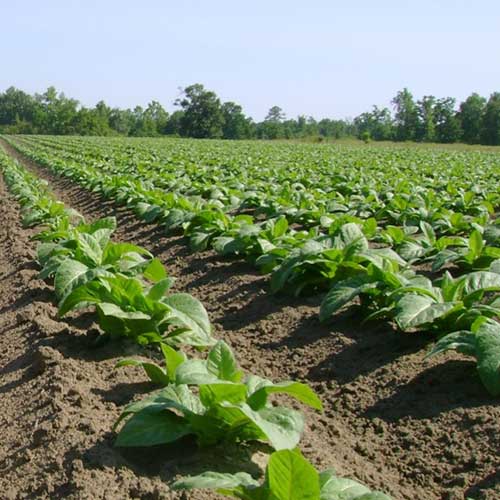Effects from soil borne pests combine to reduce yield and crop quality.
Tobacco Fumigation requires an effort in field preparation beyond simply applying the products.
Pathogens can embed in the roots or hard dirt clogs. Special care needs to be taken to plow the fields and remove the roots from pervious crops and break apart the cogs before proper fumigation in order to maximize the effect.
The solution is providing plants a healthy, disease-free soil to maximize growth and yield. Soil fumigation with Chloropicrin is a proven tool to improve soil health in many crops across the globe. Chloropicrin improves soil microbiology by rebooting the microbial balance between beneficial and harmful organisms creating a vigorous growing environment for tobacco.
Chloropicrin has been proven very effective in numerous university tests at providing enhanced disease and nematode control in the soil. This result is improved plant performance which is a direct result of improving the soils overall health. Chloropicrin is a true fumigant and moves easily through the soil breaking down into natural plant nutrients after a period of 10-14 days (with optimum environmental conditions). This gives growers the additional benefit of minimal plant back interval after fumigation with Chloropicrin versus other fumigants.
These combined benefits make Chloropicrin the most versatile fumigant for a tobacco production system. The results from using Chloropicrin can be increased yield, improved quality and higher return on investment.
Black Shank Fungicide Trial; study director Thomas A. Melton
Person Co., NC
Ridomil-Fumigant Combinations for the control of Black Shank of Tobacco. This test was established in a national infested Vance sandy loam soil. The plots were four – 48 inch rows by 45 feet long, arranged in a randomized complete block design with 5 replications. The fumigant and Ridomil applications were made April 9th while the first cultivation treatment of Ridomil was applied June 2nd and layby treatment was June 26th. Tobacco was transplanted on May 12th. Crop vigor ratings of 1 -100 were taken on June 12 and June 26th. Black Shank incidence was evaluated on June 14th, July 29th, August 13th and August 29th. The disease index was calculated from all disease incidence evaluations, and earlier evaluations were more heavily weighted. Plots were harvested by the grower with Thomas Melton’s and crew supervision. Leaf was cured, then weighed and graded by university personal to USDA standards. Prices were assigned based on average price for the grade during the past two production seasons.
Chloropicrin at 5 gal/A and chloropicrin at 3 gal/A + Ridomil Gold 1 pt/A at first cultivation were the only treatments to significantly increase yield and reduce disease incidence.


Black Shank Fungicide Test |
|||||||||
| Treatment, Rate, Method | Yield lb/A | Value $/A | Crop Vigor (1-100) | Percent Disease | Disease Index | ||||
|---|---|---|---|---|---|---|---|---|---|
| 6-Jun | Jun 26 | Jul 14 | Jul 14 | Aug 13 | Aug 29 | ||||
| Control | 1463 bc** | 2566 bc | 56 d | 59 a | 56 a | 3 a-d | 19 ab | 33 abc | 17 a-d |
| Chloropicrin, 3 gal/A, eapre, row Ridomil Gold 4EC, 1pt/A, earpre, bcast | 1735 abc | 3045 abc | 67a | 62 a | 59 a | 3 abc | 18 abc | 27 a-d | 15 a-c |
| Chloropicrin, 3 gal/A, eapre, row Ridomil Gold 4EC, 1pt/A, 1stcult, direct | 2255 a | 3977 a | 67 a | 60 a | 59 a | 0 d | 6 c | 13 d | 6 c |
| Chloropicrin, 5 gal/A, eapre, row | 2267 a | 3964 a | 67 a | 62 a | 63 a | 2 a-d | 9 bc | 15 d | 8 dc |
| * Disease index reflects both disease incidence (%) as well as time of the season that disease appeared. Higher indices reflect more disease. **Means followed by same letter do not significantly differ (p=.05, Waller-Duncan k=100) | |||||||||